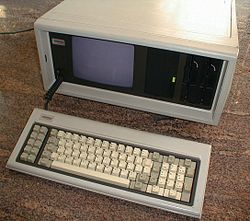- Compaq Portable
-
A Compaq Portable ready for work.Release date January 1983 Introductory price US$3,590 Operating system MS-DOS Storage capacity Two 5.25" floppy disk drives or, optionally, one floppy drive and a 10 MB hard drive Memory 128 kilobytes (expandable to 640 KiB) Display Built-in 9" green screen monitor and a unique CGA-compatible video card Weight 28 lb (12.5 kg) The Compaq Portable was the first product in the Compaq portable series to be commercially available under the Compaq Computer Corporation brand . It was the first IBM PC compatible portable computer. Compaq derived their company name from the phrase "Compatibility and Quality". Announced in November 1982 and first shipped in January 1983 at a price of US$3,590, this "luggable" suitcase-sized computer was one of the first all-in-one computers; an honor it shares with other products like the Commodore SX-64, the CP/M-based Osborne 1 and Kaypro II, and the MS-DOS-based (but not entirely IBM PC compatible) Dynalogic Hyperion. Its design was influenced by that of the Xerox NoteTaker, a prototype computer developed at Xerox PARC in 1976.
The 28 lb (12.5 kg) of computer that made up the Compaq Portable folded up into a luggable case the size of a portable sewing machine. Compaq sold 53,000 units in the first year and set revenue records for American businesses in its first three years of operation.
The Compaq Portable had basically the same hardware as an IBM PC, transplanted into a luggable case, with Compaq's custom BIOS instead of IBM's. The system came with 128 kilobytes of memory (expandable to 640 KiB), two 5.25" floppy disk drives or, optionally, one floppy drive and a 10 MB hard drive, a built-in 9" green screen monitor and a unique CGA-compatible video card. The Compaq's video card extended IBM's CGA by using 9x14 pixel character cells to generate text, rather than the usual 8x8 pixel character cells. This was made possible through the use of a display that could switch between 200 or 350 scan lines. While this was more expensive than IBM's design, it allowed Compaq to combine the graphics capability of the IBM CGA with the clearer text of the IBM MDA, thereby making the Compaq Portable very well suited for the spreadsheet software driving computer sales at the time. With a larger external monitor, this graphics hardware was also used in the original Compaq Deskpro desktop computer.
Compaq's efforts were possible because IBM had used mostly off-the-shelf parts for their PC, and because Microsoft had kept the right to license MS-DOS to other computer manufacturers. The only part which had to be copied was the BIOS, which Compaq did legally by reverse engineering through clean room design at a cost of $1 million. Although numerous other companies soon followed its lead into the market for PC compatibles, few matched Compaq's remarkable achievement of essentially-complete software compatibility with the IBM PC (typically reaching "95% compatibility" at best) until Phoenix Technologies and others began selling similarly reverse-engineered BIOSs on the open market.[1]
This machine was the first of a series of Compaq Portable machines including the Portable Plus, Portable 286, Portable II, Portable III, Portable 386, Portable 486 and Portable 486c.
See also
- IBM Portable
References
- ^ Alsop, Stewart (1994-01-31). "A public Windows pane to make compatibility clearer". InfoWorld. pp. 102. http://books.google.com/books?id=AzsEAAAAMBAJ&lpg=PT1&dq=%22flight%20simulator%22&pg=PT1#v=onepage&q=%22flight%20simulator%22&f=false. Retrieved February 28, 2011.
External links
Categories:- IBM PC compatibles
- Portable computers
- 1983 introductions
Wikimedia Foundation. 2010.

